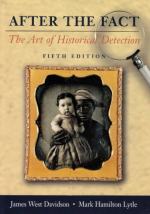|
This section contains 503 words (approx. 2 pages at 400 words per page) |

|
Chapter 3: Declaring independence Summary and Analysis
In Chapter 3, the authors narrows the book's focus to look at a single document, the Declaration of Independence.
In May of 1776, the Second Continental Congress met in Philadelphia to discuss the deteriorating relations with England. Thomas Jefferson attended, representing Virginia, and was named to a five-person committee to draft a document declaring independence. The task of writing the document was given by the committee to Jefferson, who made at least two drafts which he showed to John Adams and Benjamin Franklin, who were also on the committee and who made small alterations to the language. Jefferson then re-copied out a clean draft, which was presented to the Congress.
July 4th is now celebrated as Independence Day in the United States, however the authors point out that Congress actually voted for independence on July 2, 1776, and the resolution they...
(read more from the Chapter 3: Declaring independence Summary)
|
This section contains 503 words (approx. 2 pages at 400 words per page) |

|




